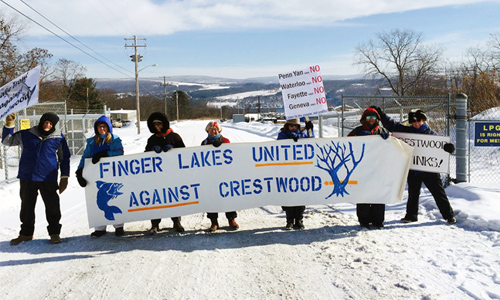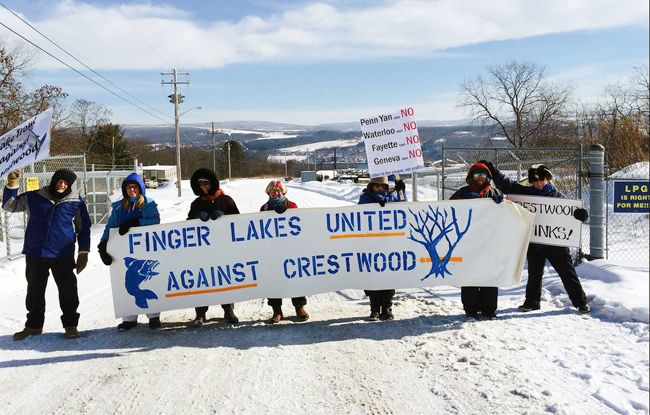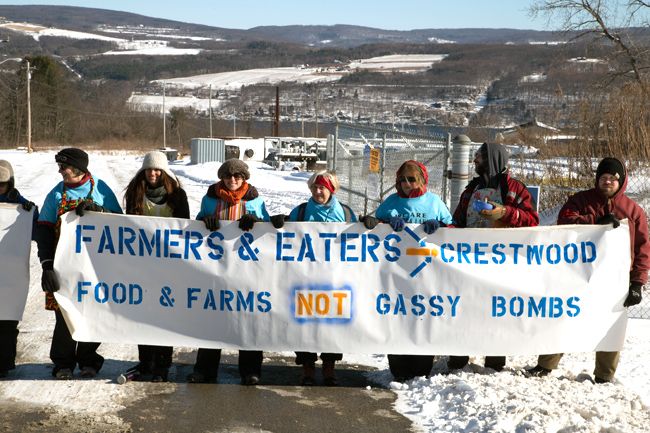

[Editor’s note: Since the We Are Seneca Lake campaign began on Oct. 23, 2104, there have been 216 arrests, with six of those arrests yesterday. The campaign is working to protect Seneca Lake and the surrounding Finger Lakes region from the gas storage expansion project by Texas-based energy company, Crestwood Midstream. Crestwood’s intention is to repurpose the crumbling salt mines underneath Seneca Lake’s hillside into massive gas tanks for highly-pressurized products from fracking: methane, propane and butane.]
I told the guy at the wilderness outfitter store that I needed footwear appropriate for standing motionless in frigid temperatures with occasional bouts of below-zero wind chill. For possibly long periods of time.
He asked if I was going ice fishing.
There are no guidebooks for how to carry out a sustained civil disobedience campaign during winter—let alone one that involves human blockades that intercept trucks attempting to enter a compressor station site on a steeply sloping lakeshore with 18 inches of snowpack.
Ice fishing with a chance of handcuffs. It’s as good a metaphor as any.
With that in mind, I bought a pair of waterproof boots that looked like something that you might bench-press at a gym and were guaranteed to 40 below.
After two hours of standing on ice at 10 above, my feet were—surprise!—distressingly cold. I would have returned the boots except that a sustained civil disobedience campaign, with all participants vetted and trained, is also like planning and executing a wedding every week. No time for more shopping. The boots would have to do.
At its core, the ongoing We Are Seneca Lake protest, now in its fourth month, is unsurprising.
A Houston-based energy company called Crestwood bought 500 acres of real estate in the prettiest place you’ve ever seen—on the shores of Seneca Lake, smack in the middle of New York’s wine country—and began to lay plans to turn it into the gas storage and transportation hub for the entire Northeast. It proposes to do so by repurposing crumbly, unlined, lakeside salt caverns, left over from a century of salt mining, into holding tanks for fracked gases: methane, butane and propane.
Brine pits. Flare stacks. Pipelines. Compressor stations. Tanker trains hauling explosive liquids across rickety rail trestles that traverse waterfall-filled—and tourist-filled—gorges.
You’d be mad, too, if you lived here.
The state of New York, which is in charge of propane and butane transportation and storage, responded to the resulting hue and cry by putting its part of the project on hold, pending an Issues Conference convened by the NYS Department of Environmental Conservation. A possible prelude to a full judiciary hearing, the Issues Conference is scheduled for today, Thursday, Feb. 12, in the village of Horseheads, and for this purpose, the local Holiday Inn Express is to be transformed into a courtroom.
In contrast, the Federal Energy Regulatory Commission (FERC), which is in charge of methane transportation and storage, swept aside public concerns, scientific objections and unresolved questions about geological instabilities, fault lines and possible salinization of the lake caused by pressurizing the salt caverns with hydrocarbon gases. With no recourse for appeal, FERC blithely approved natural gas storage in the caverns.
Seneca Lake provides drinking water for 100,000 people.
On the morning of Jan. 28, the leading edge of what may have been the world’s first farm-to-table civil disobedience action arrived at the gates.
By the time I got there, ten minutes later, two oak banquet tables—each laden with steaming dishes of food—were standing, like mirage, in the snow-drifted strip of land before the compressor station fence.
I could not have been more surprised.
There were meatballs, sauerkraut, noodles, artisanal bread, popcorn, salads, cheeses, honeycombs, pate, maple syrup-drenched pastries, bowls of apples and cakes of various flavors—all prepared from local, seasonal ingredients. There were three kinds of hot tea, jars of grape juice and cider, artful centerpieces and a portable compost station.
And people kept arriving: farmers, chefs, bakers, caterers, wine makers, maple syrup makers, bartenders, restaurant owners, agri-tourism committee chairs, authors of cookbooks.
They wore coveralls, kitchen aprons, chef’s hats and bee-keeper veils. And that’s how 65 luminaries in the Finger Lakes food and farming industry staged a protest in the form of an al fresco feast
I spied celebrity chef Scott Signori conversing over frittatas while standing in a snowdrift with legendary organic farmer Tony Potenza—New York’s first certified organic farmer who has been growing tofu beans for 41 years—and I would have walked over to say hello, but it was my job to watch for squad cars. And tweet.
The farm and food blockade was the brainchild of Emma Frisch, a local chef and hotelier who is a rising Food Network star, and she took a convivial approach to protesting.
There were toasts, blessings and speeches. Between bites of pickled carrot, the guests at the feast testified to the threat that gas storage—and the massive industrialization that accompanies it—poses to the culinary bounty of the Finger Lakes. Emma proclaimed, in her particular effervescent style, that standing at the gates of a natural gas compressor station, with dishes to pass that represent the Finger Lakes region, brought to life the essence of this region and what is at stake here.
[youtube https://www.youtube.com/watch?v=uzfL3dyskAM&feature=em-share_video_user
expand=1]
It was eating as an act of trespass and an act of belonging at the same moment.
Stefan Senders, 56, owner of the Wide Awake Bakery in nearby Trumansburg, provided a rousing statement.
“I am here with members of my community—with farmers and restauranteurs, chefs and winemakers, cheese-makers, cider-makers, and bakers—to stand in support of our lakes and land. As food makers, we have devoted our lives to caring for our neighbors. We are in it for the long haul. We are not willing to sacrifice each other for a promise of boomtown money and a shaky guarantee of safety. They tell us, ‘Nothing can go wrong.’ But we have had enough experience to know: It can go wrong. It does go wrong. It has gone wrong.”
His forceful words did not surprise me. Gentle baker or not, Senders had been arrested twice already at these gates, most recently while dressed as Santa Claus. I’d seen the man in handcuffs. He was not messing around.
After the meal, some guests at the feast rallied along the edge of the highway, while others blockaded Crestwood’s driveway. Waving whisks and rubber spatulas, they blocked the main entrance to Crestwood for four hours in frigid temperatures, preventing all traffic from entering or leaving the facility.
A state trooper drove by, slowed down, took in the banquet tables, and sped off. Later, a county deputy stopped and gave us some tips on how to safely cross the highway. No arrests.
At 3:30 p.m. the protesters dispersed, bearing their empty crocks and pie pans before them, and Frisch told me that she was not at all surprised at the spectacular turnout, “Food is the universal language that brings people together.”
I laughed, even though my feet were freezing, because, a month earlier, in the exact spot where she was standing, 28 musicians had played an outdoor concert while blockading and one of them had said, “Music is the universal language that brings people together.
But they were all arrested.
The fathers and grandfathers blockade on Feb. 4 ended quickly. Within 25 minutes, three trucks were blocked. Fifteen minutes thereafter, all ten defenders were in custody.
Residents of six different counties, they included 83-year-old Jim Connor, who blockaded in a wheelchair, and his wife Sharon, who was the lone woman among them. Connor had missed being arrested during the day-long MLK Day blockade—he’d become dangerously cold and had to leave before law enforcement arrived—but now deputies were gently helping him into the front seat of the paddy wagon, under direction from Sharon, who was also under arrest.
Somehow, in spite of its speed, the action had seemed to unfurl in slow motion. I was so surprised by what the dads had to say that I had entirely neglected my logistical obligations.
It started when John Dennis, 64, of Lansing and Daryl Anderson, 61, of Hector—both teachers—said their actions as civil disobedients were in memory of the deaths of their respective sons two years ago.
Anderson and Dennis, who met each other in a local bereavement group, commuted together to the blockade.
Got that?
Anderson said, “In the past two years, I had a child of mine die and a granddaughter born. I think in those two years, I’ve learned something about what’s important in life. The first event makes you wonder if you can go on. The second event, the granddaughter, makes you know you have to go on and think about the future. Since the 1980s, I’ve watched the fossil fuel industry wrap its tentacles around our culture and take away our choices. My nine-month-old granddaughter deserves a fossil-fuel free future.”
Anderson’s son, Collin Anderson, had worked as a substitute teacher in the Trumansburg middle school along side his father, who recently retired as a math teacher.
That’s where my own son goes to school, and both men were his teachers.
Collin died Feb. 7, 2013 of injuries sustained in a traffic accident. He was 26.
Dennis’s son, Christopher Dennis, drowned in Cayuga Lake on May 22, 2013, only days before graduating from Cornell University. Chris was 22. His body was never recovered.
Cayuga Lake and Seneca Lake are connected, as his father pointed out to us.
I knew Chris Dennis. He was a talented videographer for New Yorkers Against Fracking and Don’t Frack New York. (You can see his work here.)
And then Jim Connor said, “I am here to help protect the air, water and land from the idea to store gas in the caverns where it is very, very dangerous. I am here to protect the lake for myself, the people here, and for my children—two boys.”
Thus did I hear an 83-year-old man in a wheelchair refer to his sons as boys while blocking two trucks with his disabled body in the name of protecting them.
Because, no matter how old, that’s what parents do.
Hell, that’s what fathers do, said Doug Couchon, 64, of Elmira, who was leading the action that day and delivered a short speech to the blockade line.
[youtube https://www.youtube.com/watch?v=MLFXd8Lnj_8
expand=1]
“We are used to playing the role of protector. It’s what we do. We would not stand by and allow an immediate threat to harm a family member. We would put ourselves in harm’s way to protect our loved ones. We have done this before. And now we do it here. Crestwood’s actions and intentions present a clear and present danger to our wellbeing and that of our families and communities. And we will do what it takes to eliminate the threat. And we will do it peacefully and nonviolently. We will do it with our good minds and strong hearts working together. We will do it with love leading the way. And we will win the battle at these gates.”
It was the most conservative of speeches in the most radical of settings. I was never happier to be in the presence of men.
I also, suddenly, missed my dad. Because, no matter how old, that’s what children do.
Feb. 6 was the 54th anniversary of the Civil Rights “jail-in” movement that began when ten black college students, arrested for sitting at a segregated lunch counter in South Carolina, refused to post bail.
Bill Kitchen, 62, of Johnstown had told me, weeks prior, that he thought it an auspicious date for a Pete Seeger-themed blockade at Crestwood, which he wanted to help organize.
Also, it would commemorate the one-year anniversary of Seeger’s own death.
Okay.
I had no idea what to expect. What happened was that three-dozen people from at least ten different New York counties drove through the night in pretty terrible weather to stand at the gates of Crestwood Midstream all day in frigid temperatures. Fourteen of them blocked all traffic from entering for five hours.
During that time, they sang every Pete Seeger song in the repertoire, sometimes in harmony. They held banners saying, “If Pete was Alive He’d be 95, Standing At the Crestwood Gates!” and “Pete Seeger Friends For Clear Water: Hammering Out A Warning!”
[youtube https://www.youtube.com/watch?v=-j9Or5_IQ2I&feature=youtu.be
expand=1]
Clearwater is the name of the sailing vessel that Seeger used to draw attention to chemical contamination on the Hudson River as well as the name of the annual summer music and environmental festival founded by Seeger. An avid environmentalist, Seeger was active in the Civil Rights Movement, and, near the end of his life, in New York’s anti-fracking movement. One of Seeger’s last public performances, live at Farm Aid 2013, included a call to end fracking.
[youtube https://www.youtube.com/watch?v=dLnoqFAt9TQ
expand=1]
Kitchen, who had helped arrange that final appearance at Farm Aid, said, “Among Pete Seeger’s biggest accomplishments was cleaning up the Hudson River. If he were alive today, I think he would be asking, “How could they turn Seneca Lake into a gas station?” My actions are in remembrance of Pete and the kind of citizen he was.
A lot of Kitchen’s fellow blockaders came from the Hudson Valley—and not just because it was Seeger’s home. As they explained to me, Crestwood brings more oil out of North Dakota’s Bakkan Shale than just about anyone—and a lot of that ends up in the Hudson River valley. That was a surprise to me.
Shioban Burke, 31, of Troy, said, “I’m blockading in memory of Pete Seeger, but I’m also doing this because I think it’s time for a statewide solidarity movement against fracking infrastructure build-out. Crestwood is responsible not only for proposed project near Seneca Lake but also for loading the oil trains that arrive every day in Albany near where I live.”
And then the wind picked up, the temperature dropped further and the blockaders sang once again, “We Shall Overcome.” My feet were comfortably numb.

 233k
233k  41k
41k  Subscribe
Subscribe 

